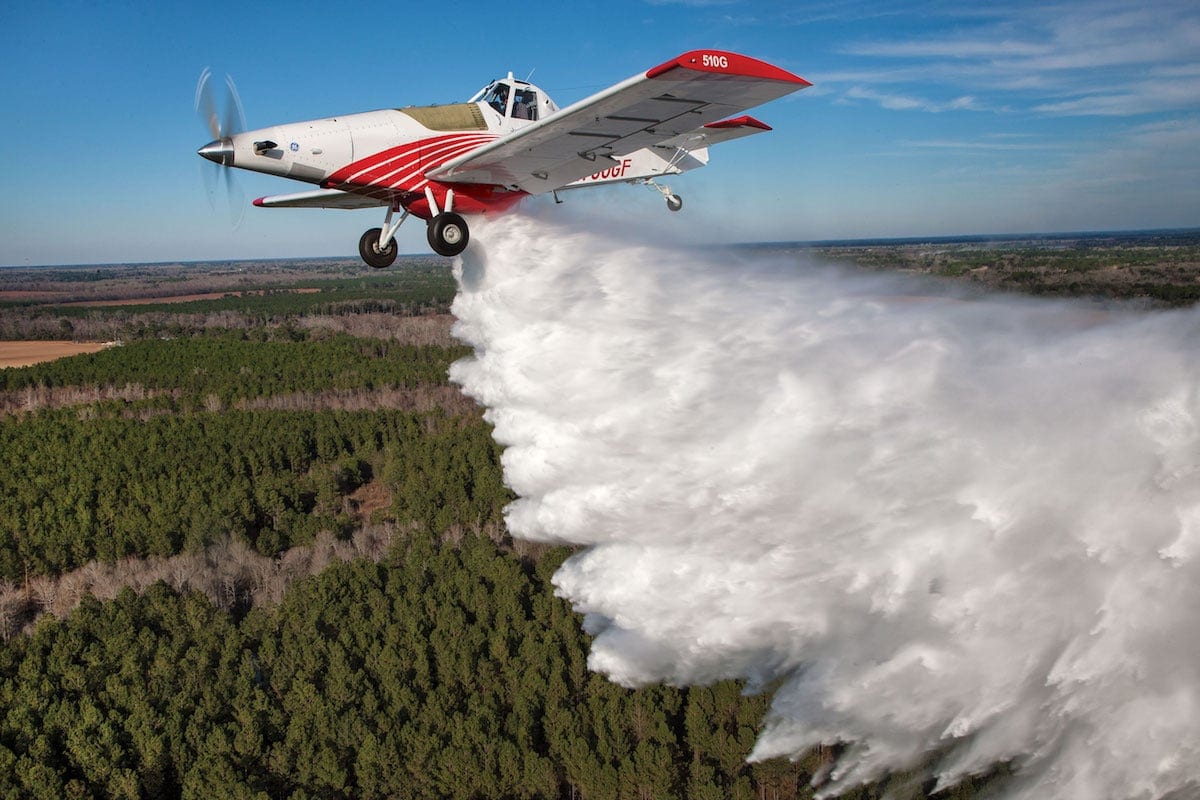The arsenal of airborne tactics available to firefighters and first responders may soon grow as Thrush Aircraft has formed an alliance with unmanned aerial vehicle and systems manufacturer Drone America to begin development of the world’s first autonomous air tanker.
The new tanker is expected to blend Thrush’s airframe and airborne delivery system expertise with Drone America’s “Ariel” amphibious platform, resulting in an aircraft capable of delivering 800 gallons of water or fire retardant, autonomously.

The aircraft will also have the ability to conduct long-duration tactical surveillance flights over a fire to give firefighters, operations managers, and public safety coordinators on the ground real-time understanding of conditions and fire behavior, according to company officials.
“As the almost incomprehensible devastation of the 2017 fire season has shown, there is virtually no limit to the level of destruction to property and natural environments wildfires can cause,” said Mike Richards, president and CEO of Drone America. “We founded our company on the belief that highly-reliable, well-integrated autonomous systems can significantly improve public and environmental safety. Our collaboration with Thrush represents a major step forward in achieving that goal, and we’re excited to be joining forces in the fight against one of our country’s most challenging foes: Wildland fires.”
Currently, only manned air tankers are used in airborne firefighting operations, and they are restricted from fighting fires during night hours, company officials note. However, it is during this “dark window” that autonomous tankers can take special advantage of the cooler night temperatures and reduced fire activity to support tactical ground operations, without risking the lives of pilots, officials point out.
In addition to tanker duties, unmanned aerial vehicles (UAVs) orbiting high above other firefighting aircraft and equipped with infrared cameras, sensors and integrated communications equipment are well-suited to systematically map and communicate fire intensity, rate and direction of spread.
This high-level, on-scene intelligence gathering not only enhances civilian and firefighter safety on the ground, but also helps solve one of the most vexing problems of disaster response: Linking voice and data transmissions across different and otherwise incompatible communication systems, company officials said.
Teams from both companies will also explore other unmanned heavy-payload applications, such as humanitarian aid, disaster relief, remote cargo transportation, and maritime patrol, officials said.
Headquartered in Albany, Georgia, Thrush Aircraft manufactures a range of aerial application aircraft used in agriculture, forestry, and firefighting worldwide. There are more than 2,100 Thrush aircraft operating in some 80 countries around the world.
Drone America designs and manufactures unmanned aerial vehicles and systems with the flexibility to capture and deliver multiple types of data. Drone America’s unmanned aircraft have the ability to simultaneously operate multiple professional-grade sensors and payloads. In addition, Drone America offers Part 107 line-of sight (LOS) and beyond-visual-line-of sight (BVLOS) flight operation training nationwide.

Soon the only thing left to do is sit around and eat donuts while computerized equipment does every aspect of our lives.Technology will continue to advance until it destroys us..
In earth-quake area’s building codes have mandated many changes in the construction of new homes. Heavy ties between the foundation and the house, metal ties for the wooden joints versus simple nailsl, etc. It is time for similar changes to the construction of homes in these known wildfire, heavily wooded areas. Boy Scouts are taught how to build a fire by placing sticks in a loose pile to provide free flow of air (oxygen) to the pile of sticks. 2 x 4’s anyone? Visualize a home without its wooden siding and cedar shake roof’s. Lets get real folks, you know the risks so rebuild smartly or lose insurance.
Hold on…
The best tactic to fight fires is initial attack.
But, the next day, if you’re still fighting it, send aircraft at dawn! Best window to fly and fight is between 6 am and noon. No wind!
If the visibilty is an issue, it will affect the drones as well and keep them on the ground.
Now, if drones are equipped with infra red cameras, they might help but then you need a lot of Retardant or Water and the Thrush doesn’t carry much…
Not saying, there’s no future in aerial fighting drones but why spending that much money instead of investing in normal aircraft flown by experienced aviators?
It’s very clear that we’re training the last generation of professional pilots and business pilot/owners. With this very predictable development the long term job prospects for current Pro pilots also got a lot grimmer. We’re seeing the same thing today that mule skinners and wagonwrights experienced in the days of our great (great) grand parents. Only it will permeate our job markets to a much greater degree. “May we live in ‘interesting’ times…” 🙁 If there’s a good side to this, some law firms are already purchasing case screening software as an economizing measure to hiring entry level attorneys. 🙂 🙂